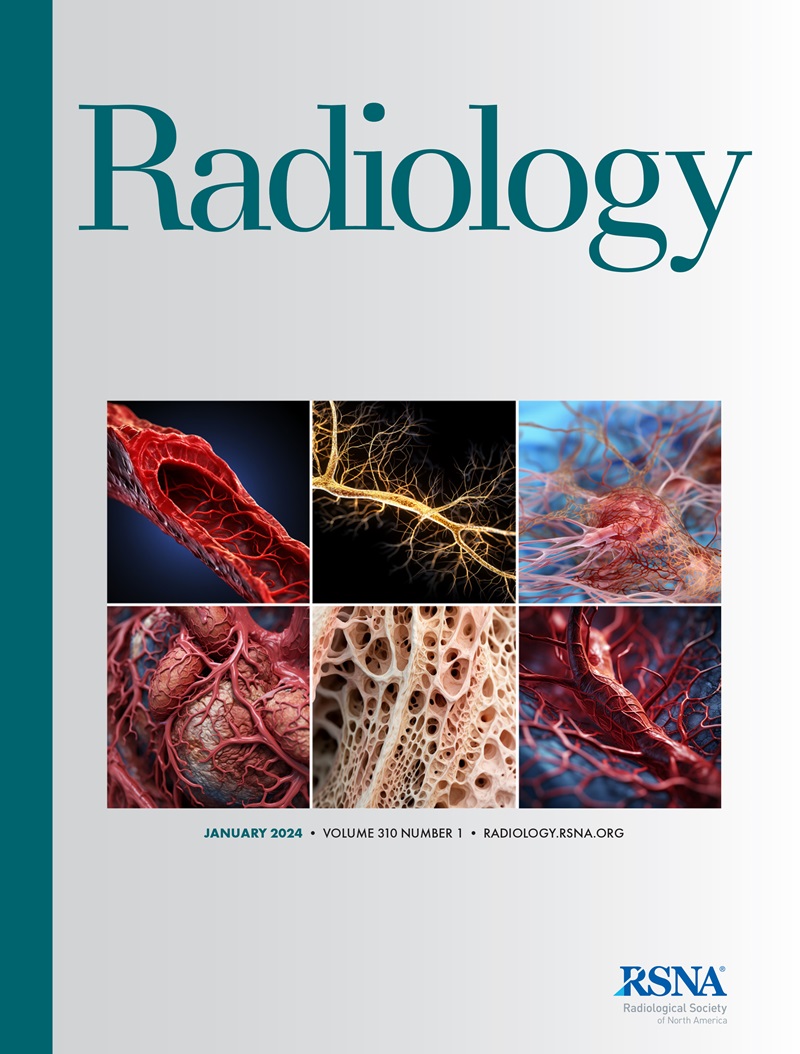Endovascular versus Best Medical Treatment for Acute Carotid Occlusion BelOw Circle of Willis (ACOBOW): The ACOBOW Study.
IF 12.1
1区 医学
Q1 RADIOLOGY, NUCLEAR MEDICINE & MEDICAL IMAGING
Lukas Meyer, Gabriel Broocks, Maria Alexandrou, Álex Lüttich, José Ángel Larrea, Wolfram Schwindt, Hermann Krähling, Weis Naziri, Daniel Behme, Maximilian Thormann, Hanna Styczen, Cornelius Deuschl, Christoph Kabbasch, Charlotte Zaeske, Charlotte Weyland, Moritz Roman Hernández Petzsche, Christian Maegerlein, Hanna Zimmermann, Marielle Ernst, Ala Jamous, Manuel Moreu Gamazo, Carlos Pérez-García, Pedro Navia, Andrés Fernández Prieto, Leonard Yeo, Benjamin Tan, Anil Gopinathan, Eberhard Siebert, Milena Miszczuk, Stefan Schob, Peter Sporns, Joaquín Zamarro Parra, Guillermo Parrilla, Fabian Arnberg, Tommy Andersson, Kamil Zeleňák, Panagiotis Papanagiotou, Marios Psychogios, Markus Möhlenbruch, André Kemmling, Franziska Dorn, Mohamed Elsharkawy, Jens Fiehler, Christian Paul Stracke
求助PDF
{"title":"Endovascular versus Best Medical Treatment for Acute Carotid Occlusion BelOw Circle of Willis (ACOBOW): The ACOBOW Study.","authors":"Lukas Meyer, Gabriel Broocks, Maria Alexandrou, Álex Lüttich, José Ángel Larrea, Wolfram Schwindt, Hermann Krähling, Weis Naziri, Daniel Behme, Maximilian Thormann, Hanna Styczen, Cornelius Deuschl, Christoph Kabbasch, Charlotte Zaeske, Charlotte Weyland, Moritz Roman Hernández Petzsche, Christian Maegerlein, Hanna Zimmermann, Marielle Ernst, Ala Jamous, Manuel Moreu Gamazo, Carlos Pérez-García, Pedro Navia, Andrés Fernández Prieto, Leonard Yeo, Benjamin Tan, Anil Gopinathan, Eberhard Siebert, Milena Miszczuk, Stefan Schob, Peter Sporns, Joaquín Zamarro Parra, Guillermo Parrilla, Fabian Arnberg, Tommy Andersson, Kamil Zeleňák, Panagiotis Papanagiotou, Marios Psychogios, Markus Möhlenbruch, André Kemmling, Franziska Dorn, Mohamed Elsharkawy, Jens Fiehler, Christian Paul Stracke","doi":"10.1148/radiol.240293","DOIUrl":null,"url":null,"abstract":"<p><p>Background Symptomatic acute occlusions of the internal carotid artery (ICA) below the circle of Willis can cause a variety of stroke symptoms, even if the major intracranial cerebral arteries remain patent; however, outcome and safety data are limited. Purpose To compare treatment effects and procedural safety of endovascular treatment (EVT) and best medical treatment (BMT) in patients with symptomatic acute occlusions of the ICA below the circle of Willis. Materials and Methods This retrospective, multicenter cohort study from 22 comprehensive stroke centers in Europe and Asia includes patients treated between January 1, 2008, and December 31, 2022. Functional (modified Rankin Scale [mRS]) and clinical (National Institutes of Health Stroke Scale [NIHSS]) outcomes, safety measures (symptomatic intracerebral hemorrhage), mortality, and procedural complications were assessed. Results A total 354 patients met the inclusion criteria (median age, 72 years [IQR, 60-81 years]; median NIHSS, 13 [IQR, 7-19]). Most frequent occlusions were in the C1 segment (243 of 354; 68.6%). Of 354 patients, 82.2% (291 patients) were administered EVT. In the overall population, favorable outcomes (mRS 0-2), mortality, and symptomatic intracerebral hemorrhage occurred in 40.6% (108 of 266 patients), 25.2% (67 of 266 patients), and 7.1% (25 of 350 patients), respectively. After adjustment, no statistically significant difference in functional outcome was observed (adjusted odds ratio [AOR], 0.82 [95% CI: 0.31, 2.12]; average treatment effect, -12.7%; <i>P</i> = .19) in the EVT compared with BMT group. Symptomatic intracerebral hemorrhage (average treatment effect, -0.28%; <i>P</i> = .95) and mortality did not differ between both groups (average treatment effect, -17.1%; <i>P</i> = .07). EVT resulted in complete recanalization of the occlusion in 80.9% (229 of 283) of cases. Periprocedural distal embolization occurred in 27.8% (81 of 291 patients) and was associated with poor outcomes (AOR, 0.41; 95% CI: 0.18, 0.93; <i>P</i> = .03). Conclusion EVT did not reveal a favorable treatment effect over BMT, and both therapies were safe. EVT had a risk for periprocedural distal embolization associated with poor outcomes. © RSNA, 2025 <i>Supplemental material is available for this article.</i> See also the editorial by Daou and Chaudhary in this issue.</p>","PeriodicalId":20896,"journal":{"name":"Radiology","volume":"314 1","pages":"e240293"},"PeriodicalIF":12.1000,"publicationDate":"2025-01-01","publicationTypes":"Journal Article","fieldsOfStudy":null,"isOpenAccess":false,"openAccessPdf":"","citationCount":"0","resultStr":null,"platform":"Semanticscholar","paperid":null,"PeriodicalName":"Radiology","FirstCategoryId":"3","ListUrlMain":"https://doi.org/10.1148/radiol.240293","RegionNum":1,"RegionCategory":"医学","ArticlePicture":[],"TitleCN":null,"AbstractTextCN":null,"PMCID":null,"EPubDate":"","PubModel":"","JCR":"Q1","JCRName":"RADIOLOGY, NUCLEAR MEDICINE & MEDICAL IMAGING","Score":null,"Total":0}
引用次数: 0
引用
批量引用
Abstract
Background Symptomatic acute occlusions of the internal carotid artery (ICA) below the circle of Willis can cause a variety of stroke symptoms, even if the major intracranial cerebral arteries remain patent; however, outcome and safety data are limited. Purpose To compare treatment effects and procedural safety of endovascular treatment (EVT) and best medical treatment (BMT) in patients with symptomatic acute occlusions of the ICA below the circle of Willis. Materials and Methods This retrospective, multicenter cohort study from 22 comprehensive stroke centers in Europe and Asia includes patients treated between January 1, 2008, and December 31, 2022. Functional (modified Rankin Scale [mRS]) and clinical (National Institutes of Health Stroke Scale [NIHSS]) outcomes, safety measures (symptomatic intracerebral hemorrhage), mortality, and procedural complications were assessed. Results A total 354 patients met the inclusion criteria (median age, 72 years [IQR, 60-81 years]; median NIHSS, 13 [IQR, 7-19]). Most frequent occlusions were in the C1 segment (243 of 354; 68.6%). Of 354 patients, 82.2% (291 patients) were administered EVT. In the overall population, favorable outcomes (mRS 0-2), mortality, and symptomatic intracerebral hemorrhage occurred in 40.6% (108 of 266 patients), 25.2% (67 of 266 patients), and 7.1% (25 of 350 patients), respectively. After adjustment, no statistically significant difference in functional outcome was observed (adjusted odds ratio [AOR], 0.82 [95% CI: 0.31, 2.12]; average treatment effect, -12.7%; P = .19) in the EVT compared with BMT group. Symptomatic intracerebral hemorrhage (average treatment effect, -0.28%; P = .95) and mortality did not differ between both groups (average treatment effect, -17.1%; P = .07). EVT resulted in complete recanalization of the occlusion in 80.9% (229 of 283) of cases. Periprocedural distal embolization occurred in 27.8% (81 of 291 patients) and was associated with poor outcomes (AOR, 0.41; 95% CI: 0.18, 0.93; P = .03). Conclusion EVT did not reveal a favorable treatment effect over BMT, and both therapies were safe. EVT had a risk for periprocedural distal embolization associated with poor outcomes. © RSNA, 2025 Supplemental material is available for this article. See also the editorial by Daou and Chaudhary in this issue.
血管内治疗与最佳药物治疗急性颈动脉壁环下闭塞(ACOBOW): ACOBOW研究
背景:威利斯圈以下的颈内动脉(ICA)急性症状性闭塞可引起多种脑卒中症状,即使颅内主要脑动脉保持通畅;然而,结果和安全性数据有限。目的比较血管内治疗(EVT)与最佳药物治疗(BMT)治疗急性威氏圈下内眦动脉闭塞的疗效及手术安全性。材料和方法这项回顾性、多中心队列研究来自欧洲和亚洲的22个卒中综合中心,纳入了2008年1月1日至2022年12月31日期间接受治疗的患者。评估功能(改良Rankin量表[mRS])和临床(美国国立卫生研究院卒中量表[NIHSS])结局、安全措施(症状性脑出血)、死亡率和手术并发症。结果354例患者符合纳入标准(中位年龄72岁[IQR, 60-81岁];NIHSS中位数,13 [IQR, 7-19])。最常见的闭塞发生在C1段(243 / 354;68.6%)。354例患者中,82.2%(291例)接受EVT治疗。在总体人群中,良好结局(mRS 0-2)、死亡率和症状性脑出血发生率分别为40.6%(266例患者中108例)、25.2%(266例患者中67例)和7.1%(350例患者中25例)。调整后,两组功能结局无统计学差异(调整优势比[AOR], 0.82 [95% CI: 0.31, 2.12];平均治疗效果-12.7%;P = 0.19)。症状性脑出血(平均治疗效果-0.28%;P = 0.95),两组间死亡率无差异(平均治疗效果-17.1%;P = .07)。EVT使80.9%(283例中229例)的闭塞血管完全再通。围手术期远端栓塞发生率为27.8%(291例患者中有81例),并与不良预后相关(AOR, 0.41;95% ci: 0.18, 0.93;P = .03)。结论EVT治疗效果不优于BMT,两种治疗方法均是安全的。EVT有术中远端栓塞的风险,预后较差。©RSNA, 2025本文可获得补充材料。请参阅Daou和Chaudhary在本期的社论。
本文章由计算机程序翻译,如有差异,请以英文原文为准。

 求助内容:
求助内容: 应助结果提醒方式:
应助结果提醒方式:


